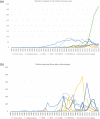Mapping the coevolution, leadership and financing of research on viral vectors, RNAi, CRISPR/Cas9 and other genomic editing technologies
- PMID: 32294089
- PMCID: PMC7159216
- DOI: 10.1371/journal.pone.0227593
Mapping the coevolution, leadership and financing of research on viral vectors, RNAi, CRISPR/Cas9 and other genomic editing technologies
Abstract
Genomic editing technologies are developing rapidly, promising significant developments for biomedicine, agriculture and other fields. In the present investigation, we analyzed and compared the process of innovation for six genomic technologies: viral vectors, RNAi, TALENs, meganucleases, ZFNs and CRISPR/Cas including the profile of the main research institutions and their funders, to understand how innovation evolved and what institutions influenced research trajectories. A Web of Science search of papers on viral vectors RNAi, CRISPR/Cas, TALENs, ZFNs and meganucleases was used to build a citation network of 16,746 papers. An analysis of network clustering combined with text mining was performed. For viral vectors, a long-term process of incremental innovation was identified, which was largely publicly funded in the United States and the European Union. The trajectory of RNAi research included clusters related to the study of RNAi as a biological phenomenon and its use in functional genomics, biomedicine and pest control. A British philanthropic organization and a US pharmaceutical company played a key role in the development of basic RNAi research and clinical application respectively, in addition to government and academic institutions. In the case of CRISPR/Cas research, basic science discoveries led to the technical improvements, and these two in turn provided the information required for the development of biomedical, agricultural, livestock and industrial applications. The trajectory of CRISPR/Cas research exhibits a geopolitical division of the investigation efforts between the US, as the main producer and funder of basic research and technical improvements, and Chinese research institutions increasingly leading applied research. Our results reflect a change in the model for financing science, with reduced public financing for basic science and applied research on publicly funded technological developments in the US, and the emergence of China as a scientific superpower, with implications for the development of applications of genomic technologies.
Conflict of interest statement
The authors have declared that no competing interests exist.
Figures





References
Publication types
MeSH terms
LinkOut - more resources
Full Text Sources

